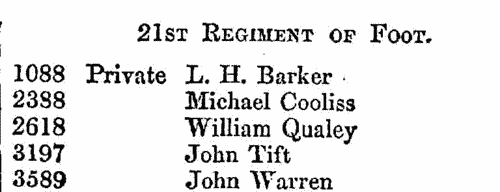Our indexes include entries for the spelling howes. In the period you have requested, we have the following 853 records (displaying 541 to 550):
Insolvents in Prison in Lancaster
(1853)
Perry's Bankrupt and Insolvent Gazette was issued monthly on the 1st of each month. Volume 28, for 1853, comprises issues numbers 325 to 336. The contents, compiled from the official sources, are mainly summaries of proceedings in the bankruptcy and insolvency courts, names of creditors, dissolution of partnerships and similar matters that would be of interest to the commercial world and their solicitors. This section, entitled 'Estates vested in Provisional Assignees' lists insolvents whose cases were dealt with in the Insolvent Court, whether on their own petitions or those of creditors. These twelve monthly issues cover the proceedings of the court from 4 December 1852 to 26 November 1853. Within each session the insolvents are listed alphabetically by surname, with address, occupation, and the name of the prison in which then held. | Sample scan, click to enlarge

|
Bankrupts
(1854)
Bankruptcy notices for England and Wales: bankruptcy often caused people to restart their lives elsewhere, so these are an important source for lost links
| Sample scan, click to enlarge

|
Bankrupts: Adjournment of Meetings
(1854)
Adjournments of meetings of creditors of bankrupts in England and Wales | Sample scan, click to enlarge

|
Bankrupts' Estates
(1854)
Transfers of bankrupts' estates in England and Wales to assignees | Sample scan, click to enlarge

|
British soldiers wounded at Inkerman
(1854)
Sebastopol in the Crimea was the great Russian naval arsenal on the Black Sea. A combined assault by British, French and Turkish troops resulted in the reduction of Sebastopol and led to the Treaty of Paris of 27 April 1856, guaranteeing the independence of the Ottoman Empire. In the battle of Inkerman, of November 1854, the Russian troops made an ultimately unsuccessful attack on the allied army. In December the War Office issued lists of soldiers killed and wounded at Inkerman: there are separate returns for 2 to 6 November, 7 to 20 November, and 21 to 26 November, as well as one for soldiers missing, and one for members of the Naval Brigade killed and wounded. This is the list of British soldiers wounded at Inkerman 2 to 6 November 1854. | Sample scan, click to enlarge

|
Dissolutions of Partnerships
(1854)
Trade partnerships dissolved, or the removal of one partner from a partnership of several traders: in England and Wales
| Sample scan, click to enlarge

|
Insolvents
(1854)
Insolvency notices for England and Wales: insolvency often caused people to restart their lives elsewhere, so these are an important source for lost links | Sample scan, click to enlarge

|
Petitioning Creditors and Solicitors
(1854)
Principal creditors petitioning to force a bankruptcy (but often close relatives of the bankrupt helping to protect his assets): and solicitors: in England and Wales | Sample scan, click to enlarge

|
 Sailors of the H. M. S. Queen who fought at Inkerman
(1854) Sailors of the H. M. S. Queen who fought at Inkerman
(1854)
Sebastopol in the Crimea was the great Russian naval arsenal on the Black Sea. A combined assault by British, French and Turkish troops resulted in the reduction of Sebastopol and led to the Treaty of Paris of 27 April 1856, guaranteeing the independence of the Ottoman Empire. By Admiralty Order the Crimea Medal was awarded to sailors and marines present during the campaign, between 17 September 1854 (the first landing at Eupatoria) and 9 September 1855 (when the allies secured Sebastopol). Her Majesty's Ship Queen, a 116-gun sailing ship, took part in the assault. Four clasps to this medal were awarded to the men present in the actions at Sebastopol itself, Inkerman, Balaklave (Balaclava) and (the sea of) Azoff. This is the roll for the sailors of the ship actually present at the battle of Inkerman, on 5 November 1854, where the Russian troops made an ultimately unsuccessful attack on the allied army. | Sample scan, click to enlarge

|
Trustees and Solicitors
(1854)
Trustees appointed to take over bankrupts' estates in England and Wales, and their solicitors. Trustees are often friends or relatives of the bankrupt: and/or principal creditors
| Sample scan, click to enlarge

|
Research your ancestry, family history, genealogy and one-name study by direct access to original records and archives indexed by surname.












